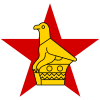History
The Torwa dynasty of the kalanga people based itself at the stone city of Khami from 1450 to 1683. Cattle and gold brought prosperity. The new culture at Khami developed both the stone building techniques and the pottery styles found at Great Zimbabwe. Masons continued to refine Great Zimbabwe’s tradition of building precise stone walls.
At Khami several artefacts are found, such as ritual drinking pots, iron and bronze weapons, copper objects and ivory divining pieces. Artifacts from Europe and China are reminders that Khami was once a trade centre.
During this period the first Europeans arrived. The first known European visitor was Antonio Fernandes, a Portuguese "degredado" (convict exile) serving his term in Sofala, who entered the Zimbabwean plateau in 1513.
There had always been an Arab influence in the region, particularly through trade, but this conflicted with Portuguese commercial interests and religion. The fall of the Tolwa state linked to the coming of the Mutapa people from the north and to the Nguni incursions from the south.
In the 1670s a new power arose on the Zimbabwean plateau led by a military ruler called the Changamire. His army of followers, known as the Lozwi, overthrew the Tolwa dynasty, drove the Portuguese from the Zimbabwean plateau in 1693, and established the Rozwi Empire (also called Mambo).

Zambia, officially the Republic of Zambia, is a landlocked country at the crossroads of Central, Southern and East Africa. It is typically referred to being in South-Central Africa or Southern Africa. It is bordered to the north by the Democratic Republic of the Congo, Tanzania to the north-east, Malawi to the east, Mozambique to the southeast, Zimbabwe and Botswana to the south, Namibia to the southwest, and Angola to the west. The capital city of Zambia is Lusaka, located in the south-central part of Zambia. The population is concentrated mainly around Lusaka in the south and the Copperbelt Province to the north, the core economic hubs of the country.

The history of Zambia experienced many stages from colonisation to independence from Britain on 24 October 1964. Northern Rhodesia became a British sphere of influence in the present-day region of Zambia in 1888, and was officially proclaimed a British protectorate in 1924. After many years of suggested mergers, Southern Rhodesia, Northern Rhodesia, and Nyasaland were merged into the British Federation of Rhodesia and Nyasaland.

Great Zimbabwe was a city in the south-eastern hills of the modern country of Zimbabwe, near Masvingo. It was settled from 1000 AD, and served as the capital of the Kingdom of Zimbabwe from the 13th century. It is the largest stone structure in precolonial Southern Africa. Construction on the city began in the 11th century and continued until it was abandoned in the 16th or 17th century. The edifices were erected by ancestors of the Shona people, currently located in Zimbabwe and nearby countries. The stone city spans an area of 7.22 square kilometres (2.79 sq mi) and could have housed up to 18,000 people at its peak, giving it a population density of approximately 2,500 inhabitants per square kilometre (6,500/sq mi). The Zimbabwe state centred on it likely covered 50,000 km². It is recognised as a World Heritage Site by UNESCO.

The Mutapa Empire – sometimes referred to as the Mutapa Kingdom, Mwenemutapa, – was an African empire in Zimbabwe, which expanded to what is now modern-day Mozambique, Botswana, Malawi, and Zambia.

Southern Africa is the southernmost region of Africa. No definition is agreed upon, but some groupings include the United Nations geoscheme, the intergovernmental Southern African Development Community, and the physical geography definition based on the physical characteristics of the land. The most restrictive definition considers the region of Southern Africa to consist of Botswana, Eswatini, Lesotho, Namibia and South Africa, while other definitions also include several other countries from the area.
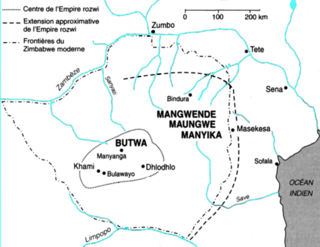
The Rozvi Empire (1480–1866) was a Shona state established on the Zimbabwean Plateau by Changamire Dombo. The term "Rozvi" refers to their legacy as a warrior nation, taken from the Shona term kurozva, "to plunder". They became the most powerful fighting force in the whole of Zimbabwe.
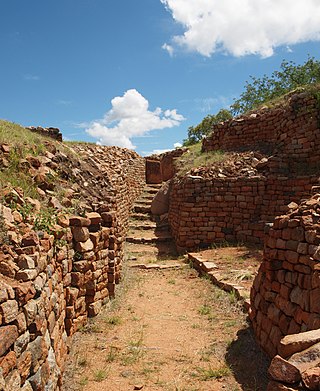
Khami is a ruined city located 22 kilometres (14 mi) west of Bulawayo, in Zimbabwe. It was once the capital of the Kingdom of Butua of the Torwa dynasty. It is now a national monument and became a UNESCO World Heritage Site in 1986.

Zimbabwe has many different cultures, which may include beliefs and ceremonies, one of them being Shona. Zimbabwe's largest ethnic group is Shona.
The Kingdom of Butua or Butwa was a pre-colonial African state located in what is now southwestern Zimbabwe. Butua was renowned as the source of gold for Arab and Portuguese traders. The region was first mentioned in Portuguese records in 1512.

The Shona people, formerly known as the Karanga are a Bantu ethnic group native to Southern Africa, primarily living in Zimbabwe where they form the majority of the population, as well as Mozambique, South Africa, and a worldwide diaspora. There are five major Shona language/dialect clusters: Manyika, Karanga, Zezuru, Korekore, Kalanga, and Ndau.
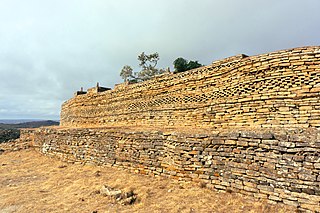
Naletale are ruins located about 25 kilometres east of Shangani in Matabeleland South, Zimbabwe and east of the Danangombe ruins.
The pre-colonial history of Zimbabwe lasted until the British government granted colonial status to Southern Rhodesia in 1923.
Zimbabwean art includes decorative esthetics applied to many aspects of life, including art objects as such, utilitarian objects, objects used in religion, warfare, in propaganda, and in many other spheres. Within this broad arena, Zimbabwe has several identifiable categories of art. It is a hallmark of African cultures in general that art touches many aspects of life, and most tribes have a vigorous and often recognisable canon of styles and a great range of art-worked objects. These can include masks, drums, textile decoration, beadwork, carving, sculpture, ceramic in various forms, housing and the person themselves. Decoration of the body in permanent ways such as scarification or tattoo or impermanently as in painting the body for a ceremony is a common feature of African cultures.
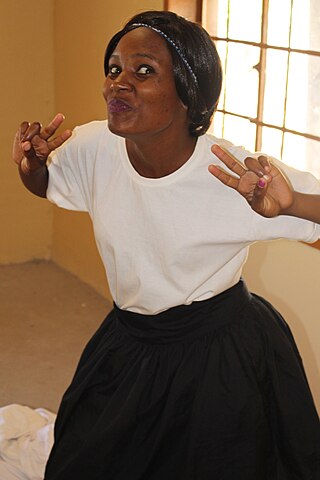
The Kalanga or BaKalanga are a southern Bantu ethnic group mainly inhabiting Matebeleland in Zimbabwe, northern Botswana, and parts of the Limpopo Province in South Africa.
Europeans first came to the region in southern Africa today called Zimbabwe in the sixteenth century, when Portuguese colonials ventured inland from Mozambique and attacked the Kingdom of Mutapa, which then controlled an area roughly equivalent to eastern Zimbabwe and western Mozambique. Portuguese influence over Mutapa endured for about two centuries before fading away during the 1690s and early-1700s (decade). During the year of 1685, French Huguenots emigrated to present-day South Africa and whilst some settled there, others moved further north into the continent. Those who did, settled within modern-day Zimbabwe, Mozambique and Botswana, and co-existed with the indigenous people; most of whom, in Zimbabwe, were the Naletale people.

The Kingdom of Zimbabwe was a Shona kingdom located in modern-day Zimbabwe. Its capital was Great Zimbabwe, the largest stone structure in precolonial Southern Africa, which had a population of 10,000. Around 1300, Great Zimbabwe replaced Mapungubwe as the most important trading centre in the interior, exporting gold to the Indian Ocean trade via Swahili city-states. The Zimbabwe state was composed of over 150 smaller zimbabwes and likely covered 50,000 km².

Thimlich Ohinga is a complex of stone-built ruins in Migori county, Nyanza Kenya, in East Africa. It is the largest one of 138 sites containing 521 stone structures that were built around the Lake Victoria region in Kenya. These sites are highly clustered. The main enclosure of Thimlich Ohinga has walls that are 1–3 m (3.3–9.8 ft) in thickness, and 1–4.2 m (3.3–13.8 ft) in height. The structures were built from undressed blocks, rocks, and stones set in place without mortar. The densely packed stones interlock. The site is believed to date to the 15th century or earlier.

Leopard's Kopje is an archaeological site, the type site of the associated region or culture that marked the Middle Iron Age in Zimbabwe. The ceramics from the Leopard's Kopje type site have been classified as part of phase II of the Leopard's Kopje culture. For information on the region of Leopard's Kopje, see the "Associated sites" section of this article.
The architecture of Zimbabwe is composed of three architectural types: the Hill Complex, the Valley Complex, and the Great Enclosure. Both traditional and colonial architectures have influenced the history and culture of the country. However, post-1954 buildings are mainly inspired by pre-colonial, traditional architecture, especially Great Zimbabwe–inspired structures such as the Kingdom Hotel, Harare international airport, and the National Heroes' Acre.
The medieval and early modern history of Africa spans from the medieval and early modern period until the colonial period in the history of Africa.
